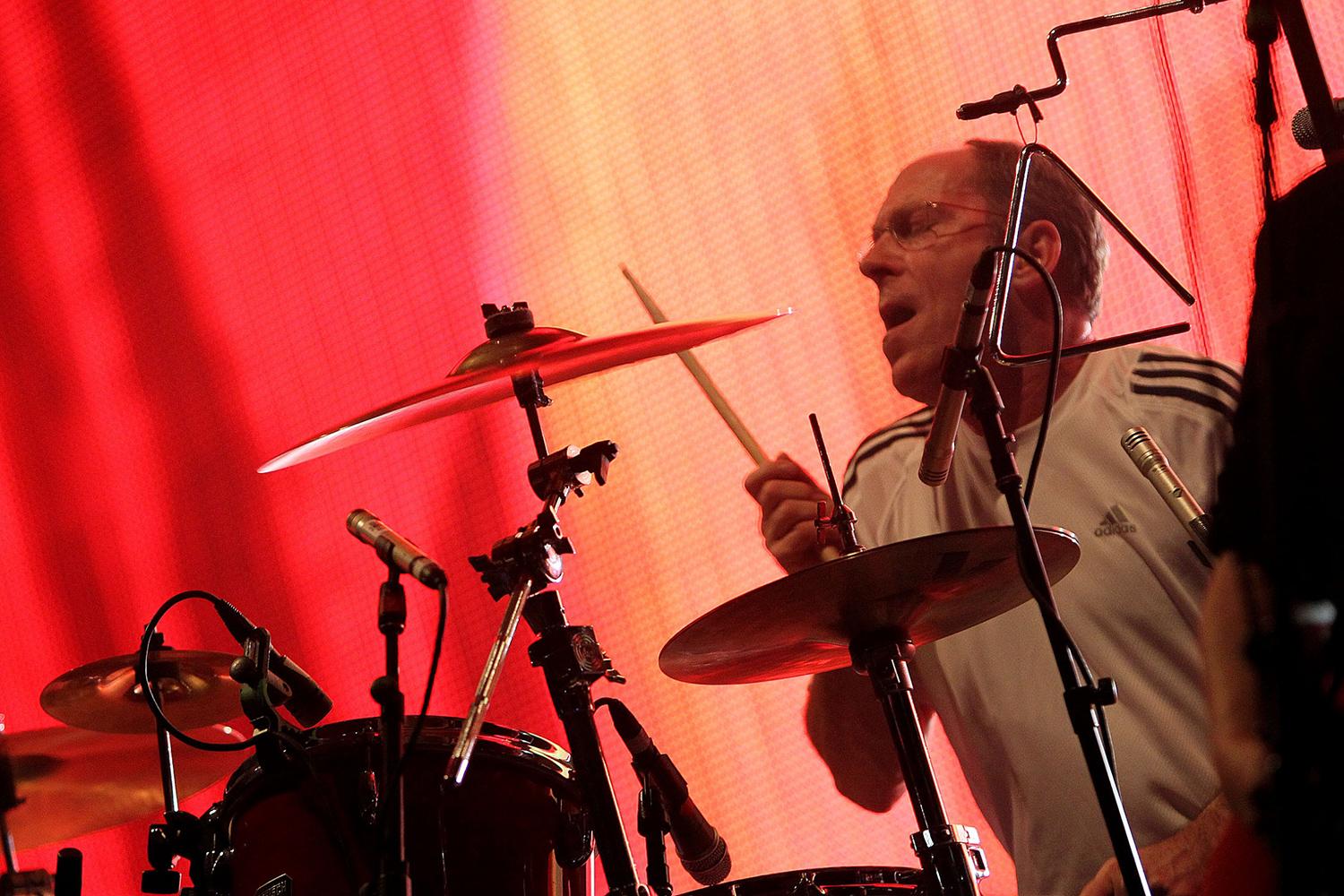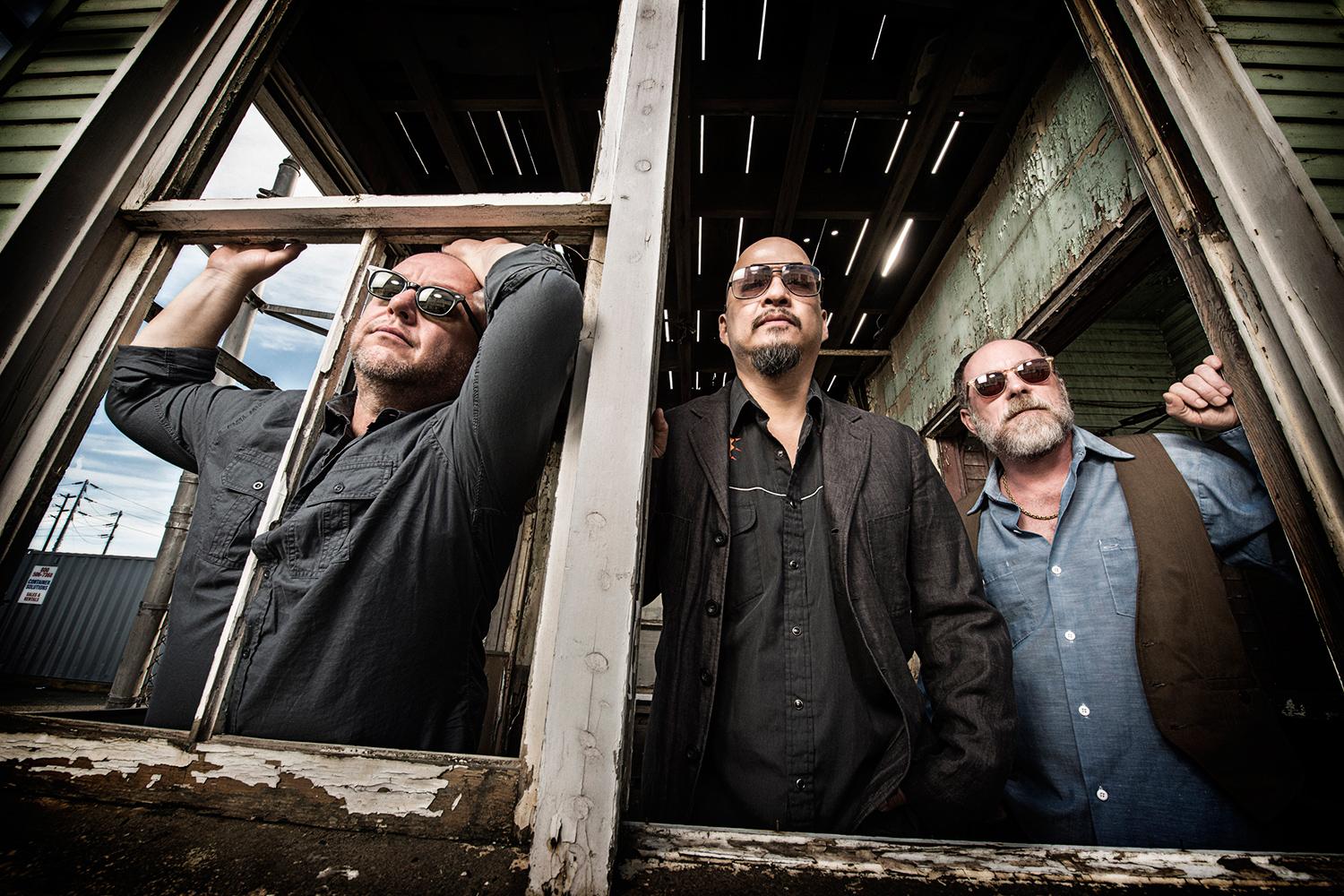
And now it’s time to let the drummer have some.
On Tuesday, Pixies guitarist Joey Santiago waxed on about the wonders of Doolittle 25, the triple-disc, 50-track collection (out via 4AD and also available digitally) that commemorates the ongoing impact of the band’s pivotal second album, released in 1989. Doolittle 25 features world-class remastering as well as dozens of unreleased demos, B-Sides, and key Peel Sessions. Besides influencing alt-rock icons Nirvana, the album’s predominant loud/soft/loud dynamic set the tone for the ’90s template many indie bands still use as their aural blueprint today. “The goal, when you’re in the studio, is to record something that’s going to last forever,” said Santiago. “And we happened to hit the mark.”
Read Part 1 of our interview: The Pixies’ Joey Santiago on Doolittle turning 25
Indeed, classic Doolittle songs like the warped, full-throttle singalong Wave of Mutilation, the scraping, riffage-dominated I Bleed, and the deeply driven shriekfest Gouge Away all show how the Pixies — singer/songwriter Black Francis (born Charles Thompson, a.k.a. Frank Black), aforementioned guitarist Joey Santiago, bassist Kim Deal, and drummer David Lovering — nailed down an indelible sonic legacy.
“The goal, when you’re in the studio, is to record something that’s going to last forever, and we happened to hit the mark.”
After getting the scoop from Santiago, Digital Trends then rang up Lovering, 52, for Part 2 of our penetrating Pixies extravaganza. Here, the Pixies drummer assesses Doolittle’s legacy, reveals how important it is to get a good snare sound, and tells what it’s like to sing one very important showcase tune from behind the drumkit most every show. We’ll all take turns, and I’ll get mine too…
Digital Trends: I asked Joey if he ever thought Doolittle would continue to have such an impact 25 years down the line — so, naturally, I have to ask you the same question. Could you have expected such a wide reverence toward this album all these years later?
David Lovering: I would have never thought that, no. Even when we hit the 20-year mark, it was still like, “What?” We initially toured on Doolittle for 2 years, and I’m quite surprised that it’s stood up. And now 25 years have gone by, and there’s still some disbelief. It’s crazy. Soon I’m going to have to listen to it with my hearing aid turned up and use my cane to go over and put it on the record player. (both laugh)
In terms of Doolittle’s sonics, what’s your take on high-resolution digital files — is that a way you’d like people to listen to this music now? I really feel like I get to hear all the subtleties via the high-res.
I’m excited to listen to it that way, yeah. We’ll always do those special things. We’ll always have the records — the old-school styling and the vinyl. But it’s nice to have technology there to do it in high-res.

Being able to feel the interaction between the players must be one of the key elements you want to hear in a mix.
Yes, yeah. Definitely. If the bass player and I are on, it’s great to have that foundation for everything else. Maybe I shouldn’t say it matters that much, but hearing those dynamics makes it so much better.
I recently played the surround-sound Blu-ray version of Monkey’s Gone to Heaven from the Minotaur box set, and I felt like I was in the middle of everything. But that mix wouldn’t work at all if Monkey wasn’t a good song to begin with. Both you and Joey have said one of the main reasons why the Pixies endure is the songs themselves. The songs are good, and that really comes across every time you hear them.
Yes, yes, I’m glad it’s not just because of the medium we’re listening to. (both laugh)
On Tame, the way Kim’s bass line and your snare go together is a classic Doolittle moment to me.
“I went and got an Artstar II, a power kit. And that was probably my favorite kit of all time.It sounded incredible.”
Oh, cool, cool. I wish I could say I was more responsible for that, but it was more [producer] Gil Norton and how it was engineered when we did that record.
What kind of sound do you want to hear when you’re listening from behind the kit?
Well, It’s interesting. If I’m playing live, it’s a completely opposite thing where I don’t have anyone in my monitors. What we’ve been doing in the last year or so has been using in-ear monitors. The only reason why is that I always just hum the song in my head and play along to that — and hopefully everyone will play along with me. (chuckles) That’s what I’m hoping so that sound isn’t that critical for me playing live. (chuckles again)
Did you give Gil and the production team any guidelines for how you wanted your kit to be miked and recorded?
This was the first opportunity where we did pre-production before recording, and we spent 2 weeks just going over the songs. Doing that, not only did we fix a lot, but it was the first time another person had ideas for us and gave some input. There were other songs we came up with during that 2-week period, too.
During that pre-production, it was wonderful that, for the first time, I had a lot of snares at my disposal. We were recording in Los Angeles, and there was a guy called the Drum Doctor. I had two snares in my kit and I had two more come in to try, and then I went through the songs in pre-production to narrow it down. Usually the snare is the most telltale, defined thing — along with the toms — so nailing down something that we liked that would be apt for each of the songs on Doolittle was important.
To me, getting a good snare sound is critical to what the band is about. If that’s recorded poorly, the character of both player and song can be lost.
Yes, Mike, I agree.
What was the kit you were playing at the time of recording Doolittle?
I was using a Tama kit, the Tama Artstar II. It was the second kit I ever had. When I started with the Pixies, I was using the kit I’d had since I was 12, a Grestch Jazz kit. Playing around Boston, that kit just wasn’t cutting it for all those gigs — especially with some of the punk songs we had — so I went and got an Artstar II, a power kit. And that was probably my favorite kit of all time in terms of sonics and the way it sounded. It sounded incredible. But it was destroyed after we were touring Doolittle. It was in a truck when we were on the road, and it got in an accident where all the cases just crushed my drums. That was the last time I saw them. I don’t see those kits anymore these days. It was a wonderful kit, the Artstar II.
And literally crushing to have it taken away from you like that.
“What’s interesting now that Kim Deal is no longer in the band is we don’t play Gigantic anymore, since that’s one of her songs to sing on.”
(laughs) It really was! It sounded that good to this day, but it’s been a number of years, man.
Doolittle features your own special lead-singing showcase number, La La Love You. Tell me how that came about. It’s become a fun live staple.
Charles had written La La Love You, but felt it would be best if I were the one singing it. And I just remember I wasn’t too keen on it. It’s interesting playing drums in a band in front of a lot of people, but being pushed forth to sing lead in front of them is double-scary. It took a little while to get. I remember a lot of drinking just to get in the spirit of it. So yeah, I pulled it off.
What’s interesting now that Kim Deal is no longer in the band is we don’t play Gigantic anymore, since that’s one of her songs to sing on. Now that we’ve gotten been back to touring, Charles is the only one singing, so sometimes we’ll play La La Love You — and the only reason I think we do is not just because it’s catchy, but it’s a nice break for the audience to not hear Charles alone or Charles with Paz [Lenchantin], our bass player, having to sing every number.
There is something different that I offer. It makes for a change during the show, and it works really well, I must say. (chuckles) I’m glad that I can pull it off and, after all these years, I learned how to play it live. I’m usually doing four things at once, but when I get to sing as well, it’s another bit of work.
You kind of have that Don Henley/Phil Collins thing going on there —
(chuckles) I guess in some way, yeah.

But I’m sure you’d rather be a singing Neil Peart — not that Neil sings, of course.
Then I’d really be huffing and puffing with the amount of work that’s going on when he plays! (both laugh)
Rush, and specifically Neil Peart, influenced you as a drummer. How nice that they’ve come around to receiving the kind of critical acclaim you guys have enjoyed from essentially the very beginning.
It’s something, yeah. They deserve it. They’re very good musicians, and that’s one of the main things I like about them. It’s interesting. I still do like Rush, but I remember very early on when I joined the Pixies, my drumming was very “busy” — I’ll just say that. A lot of my drumming was a lot of fills. And that changed very quickly, in this band. (chuckles)
Did you always know you were going to be a drummer?
Ahh, no. I had played in a couple of little local things, but I had given up drums probably for about 4 years, so I didn’t play from age 15 to 20. I didn’t pick them back up until the Pixies came up, when I was offered an audition. I had just resigned to the fact that I had to get a job and enter the real world, and that the [music] gig really wasn’t paying.
“I had just resigned to the fact that I had to get a job and enter the real world, and that the gig really wasn’t paying.”
Dave, I’m going to go out on a limb and say I think the Pixies has pretty much worked out for you as a gig.
(chuckles) Yeah, I’m happy. It’s something that I do love. It’s wonderful.
What do you like about vinyl? Joey told me how much he loves to put a record on and then just sit back, and listen.
That’s hard to say. I like the whole process itself: the player, the cartridge, the needle — just doing it, the whole ritual. It’s a wonderful thing for what it is. That’s what I enjoy the most.
You’ve had to adjust the backline since you’ve had a few different players on bass. Do you feel you have a comfortable musical dialogue going on with Paz now?
Oh yes, absolutely. It’s fantastic. Mike, she’s actually making me play better. (chuckles) She’s made me step up my game, honestly. It’s been wonderful.
Fifty years from now, people will still be listening to Doolittle because of the songs. Is that why the record endures?
As I’ve said before and as you’ve picked up on, it’s just the songs, yeah. Back then, we had a number of songs that were eclectic and dynamic, and they were all good and able to be put on the same record. Put all that together, and that’s really why we’re talking about Doolittle now. It’s a viable record.

Is there one particular song you could pinpoint as the album’s signature one to you?
Ah, interesting. Gosh. I think the one that may be my favorite is Tame, which has a nice dynamic where it goes into something hard and then into a somewhat soft kind of thing. A lot of the drumming I like to play with the Pixies is more of the harder, punk style. So for me, Tame is the most fun song to play off of Doolittle. And hopefully, it exemplifies what a Pixies song is as well.
It totally does. In terms of your audience, Joey told me he’s seeing it get younger and younger. That must be pretty exciting to get a cross-section like that, with new generations discovering who the Pixies are and what you’re all about.
Yes, yes. And it doesn’t stop. In 2004, that was my first indication that some of the audience wasn’t even born when we first came out. And now it’s 2014, 10 years later, and it’s relatively the same. We’re getting younger and younger people attending, and then people my age are bringing their kids to the show. It just keeps going on, and we’re a very fortunate band because of that.
I was lucky to see both iterations. I saw two of your shows at The Ritz in New York a year apart in November 1990 and 1991, and I also saw one of the Hammerstein Ballroom shows in December 2004. It’s nice to see more and more people discover Doolittle, and what impact it’s had — and still has. How do you feel about being labeled an alternative-rock pioneer?
(chuckles) I’m just the drummer, Mike. I’m just the drummer. This is all we do, and so this is just normal for us. It’s all good!






